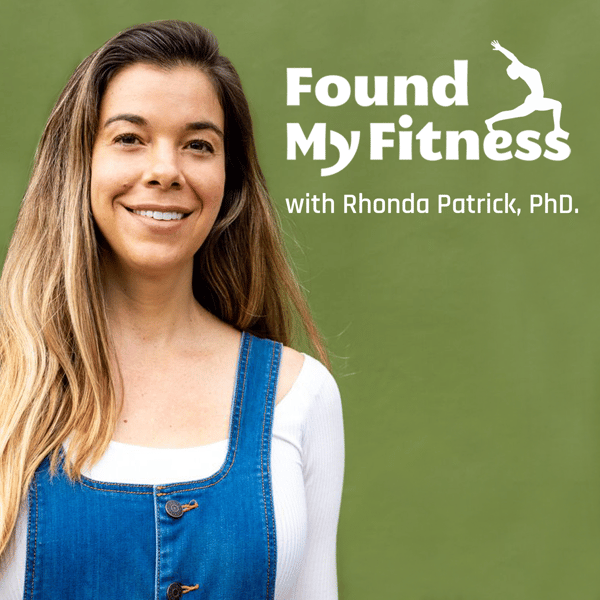#076 Building Muscle with Resistance Exercise and Reassessing Protein Intake | Stuart Phillips, PhD
FoundMyFitness
Rhonda Patrick, Ph.D.
4.8 • 5.5K Ratings
🗓️ 29 June 2022
⏱️ 116 minutes
🧾️ Download transcript
Summary
Stuart Phillips, PhD, is a professor of kinesiology at McMaster University in Hamilton, Ontario, Canada, where he also serves as the director of the Physical Activity Centre of Excellence. His research centers on the roles exercise and nutrition play in influencing human skeletal muscle protein turnover and how these lifestyle factors influence body composition, especially as we age.
In this episode, we discuss:
- 00:07:16 - Why muscle is important for longevity
- 00:14:34 - Is the importance of muscle mass (per se) overstated?
- 00:16:48 - Is the RDA on protein too low?
- 00:19:03 - Minimum vs. optimal protein intake (for athletes)
- 00:19:29 - Why older adults need more protein
- 00:24:52 - Caloric restriction vs. higher protein for aging
- 00:28:04 - What is a catabolic crisis?
- 00:29:40 - Effects of space flight on muscle
- 00:36:16 - Practical tips for protein intake
- 00:39:34 - Protein timing and the anabolic window
- 00:41:27 - Most important factors for hypertrophy
- 00:43:57 - Should we supplement leucine?
- 00:45:46 - Does plant protein support hypertrophy?
- 00:56:30 - Causes of anabolic resistance
- 00:58:22 - What types of exercise and how much?
- 01:06:56 - Protein and rest as tools for recovery
- 01:08:14 - Mechanisms of muscle protein synthesis and breakdown
- 01:08:31 - Does rapamycin inhibit hypertrophy?
- 01:13:07 - What is Dr. Phillips doing to age well?
- 01:15:25 - Hormonal responses to exercise
- 01:17:09 - Sex differences in hypertrophy
- 01:19:38 - Effect of menopause on muscle
- 01:20:03 - Do testosterone boosters work?
- 01:21:56 - Does growth hormone improve muscle?
- 01:26:30 - Androgen replacement therapy (benefits vs. drawbacks)
- 01:31:17 - Mental health benefits of exercise
- 01:31:54 - Anti-catabolic effects of heat
- 01:38:19 - Molecular causes of sarcopenia
- 01:42:35 - Anti-catabolic effects of omega-3
- 01:48:57 - Brain and muscle effects of creatine
Join over 300,000 people and get the latest distilled information straight to your inbox weekly: https://www.foundmyfitness.com/newsletter
Become a FoundMyFitness premium member to get access to exclusive episodes, emails, live Q+A’s with Rhonda and more: https://www.foundmyfitness.com/crowdsponsor
Transcript
Click on a timestamp to play from that location
| 0:00.0 | Catebolic crises fueled by events of disuse and disease. |
| 0:04.0 | What are they? Are they something that we should all be preparing for? Consider the critical threshold |
| 0:09.5 | of old age. Imagine you feel pressure to cross a busy intersection, but your ability to do so on |
| 0:15.8 | time falls at a sink with your capacity to do so. Cars are honking, you tell yourself it's the |
| 0:21.6 | last time you'll be doing that. Your gate speed, the speed at which you walk has become too slow. |
| 0:27.2 | What started as a brief period of immobilization from your routine hospital say for the flu or a |
| 0:33.5 | simple surgery has become something more. You've crossed the disability threshold. |
| 0:40.8 | The result? Habit disruption. Rather than going for your daily walk, you decide to stay home, |
| 0:47.6 | and in that moment begins the decline. The dam of daily habit that sustained your muscle, |
| 0:54.0 | although leaky from gradual sarcopenia has suddenly broken loose, and the floodgates are loose |
| 1:00.3 | propelling you towards even greater atrophy and so-called catabolic crisis. These are the punctuated |
| 1:07.2 | events of disuse and disease that may spell out a more precipitous decline. And they may be also |
| 1:14.4 | as our guest today suggests, one way in which animal models of caloric restriction popular in the |
| 1:20.8 | aging community have failed to account for. In that small respect, I think today's guest may be |
| 1:28.4 | the voice of the other side. There is good news. Even the very old, a non-aginarian or a person who |
| 1:35.7 | was from 90 to 99 years old, who may lack the capacity for meaningful improvements in muscle mass, |
| 1:42.0 | can experience large relative improvements in gate speed and strength through a few simple |
| 1:47.1 | changes in habits, in particular resistance exercise. Dr. Stuart Phillips is a professor of |
| 1:53.8 | kinesiology at McMaster University in Hamilton, Ontario, Canada, where he also serves as the |
| 1:59.6 | director of the physical activity center of excellence. His research centers on the roles |
| 2:04.8 | exercise and nutrition play in influencing human skeletal muscle protein turnover, |
| 2:10.2 | and how these lifestyle factors influence body composition, especially as we age. He is in |
... |
Please login to see the full transcript.
Disclaimer: The podcast and artwork embedded on this page are from Rhonda Patrick, Ph.D., and are the property of its owner and not affiliated with or endorsed by Tapesearch.
Generated transcripts are the property of Rhonda Patrick, Ph.D. and are distributed freely under the Fair Use doctrine. Transcripts generated by Tapesearch are not guaranteed to be accurate.
Copyright © Tapesearch 2025.

